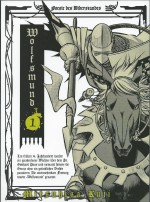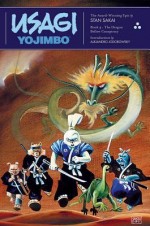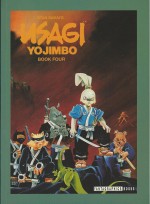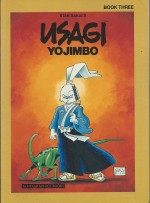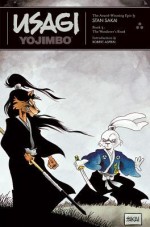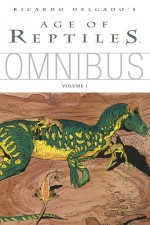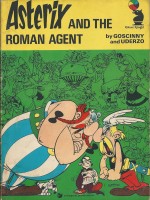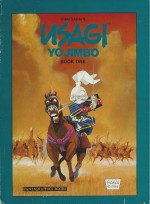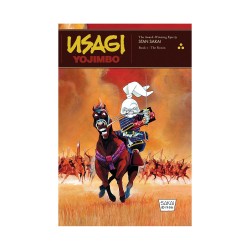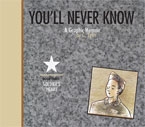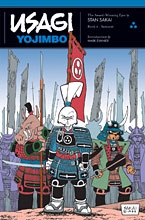
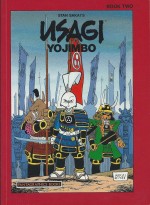
By Stan Sakai (Fantagraphics)
ISBN: 978-0-93019-338-1
Usagi Yojimbo (which translates as “rabbit bodyguardâ€) first appeared as a background character in Stan Sakai’s anthropomorphic comedy The Adventures of Nilson Groundthumper and Hermy, which launched in furry ‘n’ fuzzy folk anthology Albedo Anthropomorphics #1 (1984), subsequently appearing there on his own terms as well as in Critters, Amazing Heroes, Furrlough and the Munden’s Bar back-up in Grimjack.
Sakai was born in 1953 in Kyoto, Japan before the family emigrated to Hawaii in 1955. He attended the University of Hawaii, graduating with a BA in Fine Arts, and pursued further studies at Pasadena’s Art Center College of Design after landing in California.
His early forays into comics were as a letterer, most famously for the inimitable Groo the Wanderer, before his nimble pens and brushes, coupled with a love of Japanese history and legend and hearty interest in the filmic works of Akira Kurosawa and his peers, all combined to turn a proposed story about a human historical hero into one of the most enticing and impressive fantasy sagas of all time.
And it’s still more educational, informative and authentic than any dozen Samurai sagas you can name…
The deliriously peripatetic and expansive period epic is nominally set in a world of sentient animals (with a few unobtrusive human characters scattered about) and specifically references the Edo Period of Feudal Japan: the early 17th century of our reckoning.
It simultaneously samples classic contemporary cultural icons from sources as varied as Lone Wolf and Cub, Zatoichi and even Godzilla whilst specifically recounting the life of Miyamoto Usagi, a Ronin or masterless wandering Samurai, eking out an honourable living as a Yojimbo or bodyguard-for-hire.
As such, his fate is to be drawn constantly into a plethora of incredible situations.
And yes, he’s a rabbit – a brave, sentimental, gentle, artistic, empathetic long-suffering, conscientious and heroic everyman bunny who just can’t turn down any request for help or ignore the slightest evidence of injustice…
This sublime second monochrome compilation (which originally appeared in Fantagraphics’ Usagi Yojimbo volume 1, #1-6, from 1989), begins with an effulgent Introduction from fellow legendary Groo-grifter Mark Evanier before the comedic adventure seamlessly transformed into epic drama, in an ambitious 9-chapter serial which solidly set the scene for decades to come.
‘Samurai!’ started with the Ronin again meeting money-mad bounty-hunter Gennosuké after a deadly duel of honour left a warrior named Gunichi a bloody corpse at the Yojimbo’s feet. Pressed by the newly-arrived and curious Gen, the moodily moved and uncharacteristically loquacious rabbit began sharing some of the events of his boyhood…
Once, Miyamoto Usagi was simply the son of a small-town magistrate, dispatched with his friend Kenichi to train at the prestigious DogoraFencingSchool in Sendai.
As the boys made their journey they encountered a lone, aged warrior beset by a pack of bullies from that self-same school, determined to prove their institution’s martial superiority. Despite all efforts to placate the hotheads old Katsuichi was eventually forced to reluctantly slay the toughs. The stunned witnesses began to bicker. Whilst Kenichi wanted to follow orders and go on to the – clearly honourless – DogoraSchool, little Usagi chose to seek out the old man and make him his Sensei…
The old man was finished with teaching but eventually saw something in the defiant, determined little rabbit and grudgingly accepted his exceptional young charge…
Usagi spent years learning the Way of Bushido from his stern, leonine master: not just superior technique and tactics, but also a philosophy of justice and restraint that would serve him all his life…
The revelations of Usagi’s boyhood training continue in short, revelatory vignettes as the elder Yojimbo and his surly companion continue towards shelter, highlighting the peculiar relationship of Sensei and Student. At the disciple’s first tournament the scurrilous, vengeful Dogora adherents plan to “accidentally†cripple the boy and thus humiliate his teacher, but don’t reckon on his innate ability.
After besting the entire FencingSchool contingent in duels with wooden swords – or Bokken – the boy at last faces his old friend Kenichi and triumphs.
His prize is a Wakizashi “Young Willow†and Katana “Willow Branchâ€. The short and long swords are the soul of a samurai, marking his graduation to martial maturity, but Usagi is blithely unaware of what his victory has cost his childhood companion…
Mere months later, the graduate warrior was challenged by a masterful, mysterious swordsman who was a bodyguard to the Great Lord MifunÄ—. Their duel was interrupted when a band of Dogora assassins attacked, determined to avenge their school’s humiliation by a single stick-wielding student. The cowards were no match for the steel of Usagi and the mighty Gunichi, and the victors parted as friends, with the bodyguard promising to recommend the rabbit for future service to his Lord.
Still assessing his options the young Samurai then encountered Kenichi once more. The disgraced youth had left the DogoraSchool and was trying to drink himself to death, but when he and Usagi heard that their home village was threatened by bandits the former friends reunited to save their loved ones…
By holding Usagi’s childhood love Mariko hostage, the brigands had successfully neutralised his magistrate father and were stripping the hamlet of all its provisions and meagre treasures when Usagi and Kenichi challenged them.
None of the villains survived the vengeance of the outraged villagers.
In the aftermath although Mariko clearly wanted Usagi to stay, she said nothing and the Samurai left to join Lord MifunÄ—’s service. Kenichi stayed…
The young warrior rose quickly as MifunÄ—’s vassal and was soon a trusted bodyguard, serving beside the indomitable Gunichi. It was a time of great unrest and war was brewing. In his third year of service the Lord’s castle was attacked by Neko Ninja assassins. Although the doughty warriors managed to save their master, his wife Kazumi and heir Tsuruichi were murdered. Realising ambitious rival Lord Hikiji was responsible, MifunÄ— declared war…
The struggle ended on the great Adachigahara plain when MifunÄ—’s general Todo switched sides and the Great Lord fell. At the crucial moment Gunichi also broke, fleeing to save his own skin and leaving the helpless Usagi to preserve the fallen Lord’s head – and Honour – from shameful desecration…
The story came full circle now, when after two years as a purposeless, masterless Ronin, the wandering Yojimbo met Gunichi again…
After that epic origin yarn, Sakai returned to short, pithy vignettes to cleanse the dramatic palate, beginning with a delicious traditional horror story. In ‘Kappa’ the wanderer encounters a deadly marsh troll at dusk and barely escapes with his life by offering the foul beast some wild cucumbers he has picked. Exhausted, the Ronin finds shelter with an old woman for the night, but when she hears of his adventure she becomes hysterical.
The cucumbers were planted so that her own son – returning that night – would have something to buy off the voracious Kappa…
Horrified by his inadvertent error, Usagi dashes back to the marsh to save the son, but even after overcoming the monster shockingly learns of one final sting in this tale…
Soaking a sore back in a hot spring the wanderer befriends a newly hatched tokagé lizard (ubiquitous, omnivorous reptiles that populate the anthropomorphic world, replacing scavenger species like rats, cats and dogs in the fictitious ecosystem), but is caught off guard and ambushed by bandits. Luckily the uniquely fire-breathing ‘Zylla’ comes to his assistance, prompting the wary warrior to wonder if the lizard might be a minor deity…
This second monochrome compilation concludes at the ‘Silk Fair’ where the wanderer saves a silk-worker from marauding bandits and stays to liberate all his oppressed fellows from a miserly merchant ruthlessly exploiting them…
The Lethal Lepus has changed publishers a few times but has been in continuous publication since 1987 – with over 29 graphic novel collections and books to date. He has also guest-starred in many other series (such as Teenage Mutant Ninja Turtles and its TV incarnation) and even almost made it into his own small-screen show but there’s still time yet and fashions can revive as quickly as they die out. There are high-end collectibles, art prints, computer games and RPGs, a spin-off sci-fi comics serial and lots of toys. Sakai and his creation have won numerous awards both within the Comics community and amongst the greater reading public.
Fast-paced yet lyrical, funny, thrilling and simply bursting with veracity and verve, Usagi Yojimbo is a monolithic magical saga of irresistible appeal that will delight devotees and make converts of the most hardened hater of “funny animal†stories.
Sheer comicbook poetry by a Comicbook Sensei…
Text and illustrations © 1987, 1989, 2005 Stan Sakai. Book editions © 1989, 2002 Fantagraphics books. All rights reserved.
